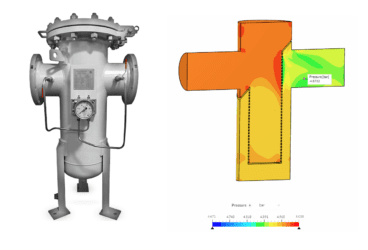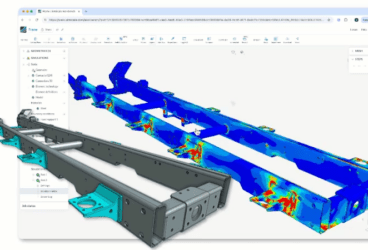Urban microclimates affect more than the hustle and bustle of busy high streets. They can dictate everything from building energy performance and the implementation of renewable energy technologies to necessary safety precautions for pedestrians and cyclists. Last year, the City of London reassessed and reclassified their acceptable microclimate conditions, in an effort to prevent future builds causing wind discomfort to tourists and city dwellers alike.
London’s new developmental guidelines aimed to formalize a very detailed and standardized framework for wind comfort assessment for the City. With that, a high-quality standard, reproducibility, and comparability of all wind studies is ensured. Additionally, the requirement of doing wind studies for all new developments higher than 25m ensures that pedestrian comfort and safety are virtually always being assessed. Finally, this new guide is the first time that cyclists have specifically been taken into consideration in such an all-encompassing standardization.

From commercial skyscrapers to residential high rises, wind can be accelerated either through narrow channels between these structures or, more concerning for passersby, from being accelerated downward towards the ground through downdraft effect.

In 2011 in Leeds, a northern UK city, accelerated wind speeds caused by the 110m-tall Bridgewater Place office and apartment building caused a truck to roll over, killing a pedestrian. This, along with other incidents, in turn, prompted a country-wide reconsideration towards wind design; with London prevailing as the biggest offender.
The Wind Microclimate Guidelines for Developments in the City of London report the required investigations to assess a proposed structure’s impact on the surrounding environment, concerning the comfort and safety of nearby pedestrians and cyclists.
Maintaining Wind Comfort in the City of London
In the City of London specifically, many skyscrapers have recently become a part of its skyline, and plans for at least 13 more are in the works to be built by 2026. One infamous tower to note, “The Walkie-Talkie” building at 20 Fenchurch Street, is a prime example of why these new guidelines have come to fruition. Existing as a safety hazard to pedestrians below, this building, among others, prompted more comprehensive safety assessments of how intended structures will affect people on ground-level, with an increased evaluation of streets and the surrounding area using detailed scale models in wind tunnels and computer-aided engineering (CAE) simulations. These evaluations essentially aim to maintain pedestrian wind comfort while urban development projects continue.

How Is Pedestrian Wind Comfort Assessed?
In order to evaluate the wind in London for existing or future developments, three components must be combined:
- Historical meteorological data close to the location of the building to get representative/typical wind conditions.
- Local wind conditions which are influenced by the building itself and its surroundings.
- Comfort criteria that relate local wind speeds to actual subjective “wind comfort”.
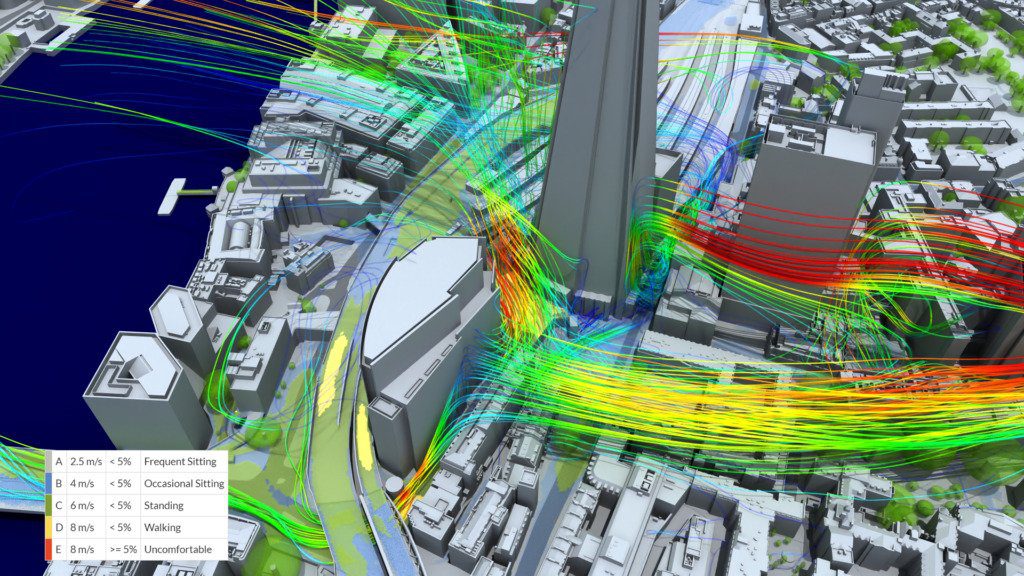
Once this information is determined, engineers must evaluate the proposed building design against the environmental conditions of the area, while conforming to the comfort criteria standard.
Real-world Simulation: Wind Tunnel Assessment
Wind tunnel testing was first used for evaluating the aerodynamics of airplanes in WW2. It was only later that wind tunnel studies were undertaken for evaluating the effects of wind on man-made structures when buildings became tall enough to present large surfaces to the wind, and the resulting forces had to be resisted by the building’s inner structure. Calculating such forces was required before building codes, wind comfort codes, or wind microclimate codes existed; and were used to basically specify the required strength of the buildings to withstand against the external wind forces.
These new microclimate guidelines apply to buildings that are above the average height of surrounding buildings (more generally, 25m above in the City of London). Though wind tunnel evaluation is a tried and tested methodology for assessing London’s famous skyline, any building that exceeds 50m height must look at additional or alternative methods of investigation. CFD is a viable additional method of assessing these wind conditions.
Online Simulation: CFD Evaluation
Within these new guidelines, computational fluid dynamics (CFD) is among one of the recommended approaches for evaluating buildings over a certain height (more specifically, 25m or higher). This standard urges engineers to address wind impact early in the design process, as well as incorporate multiple scenarios to be studied before drawing actionable conclusions.
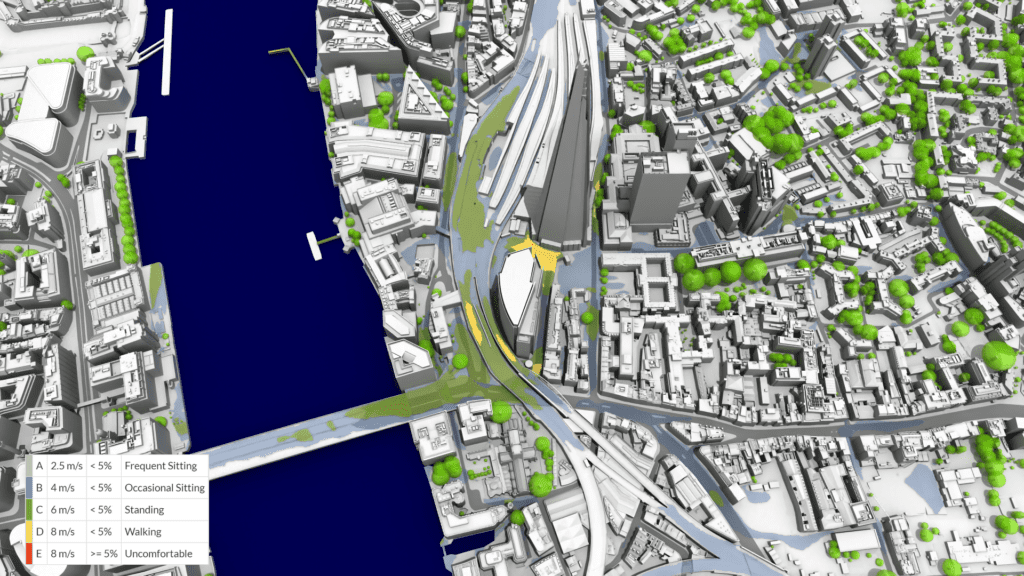

As a cost-effective and cloud-based CFD platform, SimScale is supporting UK based architects, engineers, and designers that must adhere to these new rules and contribute to a safer London.
SimScale Solution: CFD for The Wind Microclimate Guidelines for Developments in the City of London
Here at SimScale, we’ve added a specific feature dedicated to wind comfort evaluation for developments in the City of London which is in accordance with the official guidelines. In order to cut down on design time and maximize efficiency, this feature is accessible via an extremely streamlined and easy-to-use workflow. This new London wind microclimate feature also allows architects and urban planners, besides wind engineers, to get valuable insights on wind microclimate impacts, early in the design process. Using Pedestrian Wind Comfort Analysis through SimScale, users are now able to:
- Directly use the exact wind statistics data as defined in the guidelines.
- Run the wind analysis for up to 36 wind directions.
- Compute pedestrian wind comfort and safety according to the London LDDC criteria on an annual, seasonal, and also “worst season” scenario—in a single analysis.
- Analyze the wind flow patterns around the proposed buildings using streamlines, velocity vectors, and much more for each of the 36 wind directions.
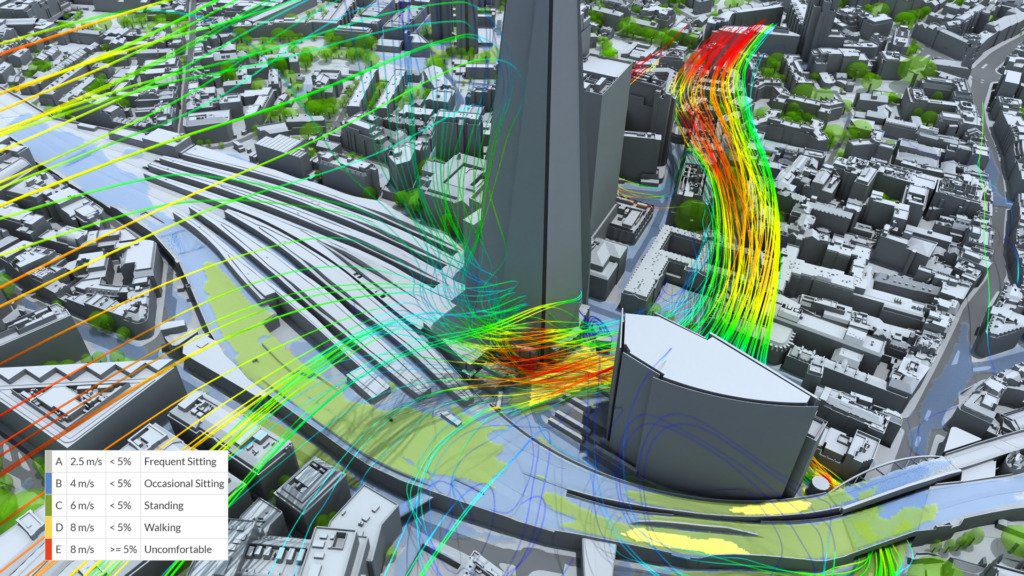
“SimScale’s workflow makes it possible for engineers to comply with the CFD requirements of the Wind Microclimate Guidelines for Developments in the City of London quickly and easily,” said Richard Szoeke-Schuller, product manager at SimScale. “Developers are guided by SimScale’s workflow to enter parameters and perform needed calculations. Because SimScale is cloud-based, multiple simulation scenarios can be run in parallel. All of this not only saves time, but allows for design validation to happen early and iteratively.” – Richard Szöke-Schuller, SimScale Product Manager

Want to Learn More About Pedestrian Wind Comfort with SimScale?
- How to Model Trees with Porous Media — Pedestrian Wind Comfort with SimScale
- How to Assess Building Aerodynamics and Wind Effects on Pedestrian Comfort
- We Simulated the Grace Building and This Is What We Found
- Wind Comfort Criteria: Lawson, Davenport, and NEN 8100
- How to Analyze Pedestrian Wind Comfort with SimScale
- Sustainable Wind Engineering: The Stockholm Royal Seaport Project
